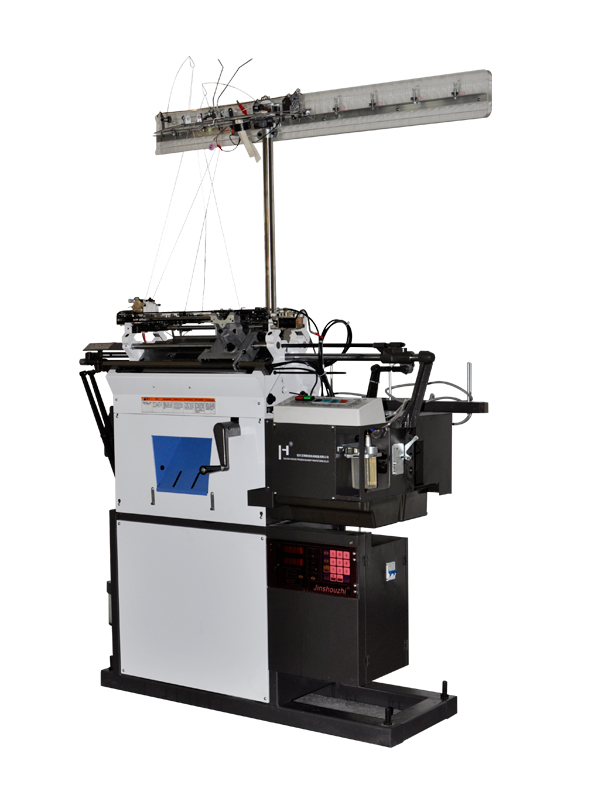Sock machine classification Sock machine can be classif […]
Sock machine classification Sock machine can be classified according to needle bed form, knitting needle type and cylinder (bed) number. The stocking machine has a higher machine size. It produces flat-width socks that change the width of each section according to the shape of the feet and legs. The range of circular socks machines is wide. The production of tubular sock blanks is adapted to the shape of the foot by changing the size of the coils of each section, or using elastic yarn, or knitting the sock head and sock. The socks of the tubular sock blank are closed to form a seamless sock. The production efficiency of the flat hosiery machine is low, and the round hosiery machine is widely used at present. Sock machine structure The round sock machine is mainly composed of a yarn feeding mechanism, a knitting mechanism, a needle selection mechanism, a control mechanism, a transmission mechanism, a density adjustment mechanism and a pulling mechanism. Some hosiery machines also have opening and folding mechanisms. The hosiery machine still has a transfer mechanism.
The function of the yarn feeding mechanism is to draw the yarn from the bobbin into the knitting area. There are two types of negative and positive types. Negative yarn feeding is to draw the yarn out of the package by tension. Although there are tensioners and tension compensation devices to control the tension and the amount of delivery, the difference in yarn tension is still large. The positive yarn feeder uses a special device to feed the yarn into the knitting area at a constant linear speed, and the yarn tension difference is small.
The function of the knitting mechanism is to pass the yarn through the loop forming machine to knit into a tubular sock blank or open-width socks. The knitting parts of the stocking machine include knitting needles, sinkers, yarn guides and triangles. Flat hosiery machines have knitting needles, bending pieces, yarn splitting pieces, loop-opening pieces, yarn guides and pressing pieces. The knitting needles of the circular hosiery machine are arranged on the cylinder, and the yarn guide is fixed around the cylinder to feed the yarn into the knitting area. There are several lines that are called several routes. Generally there are 1-12 routes. The more routes, the higher the productivity. When the cylinder rotates, the latch needle is moved up and down by the action of the triangle, and is knitted by the yarn guide. When knitting the sock heel and the head of the sock, the needle picker and the needle puller are used to retract and release the knitting needles participating in knitting to form a bag shape. The knitting needles of the stocking machine are fixedly arranged on the needle bed and move with the needle bed. The yarn guide moves along the needle bed to lay the yarn, and at the same time weaves through the cooperation of the bending piece, the dividing piece and the looping piece.
The function of the control mechanism is to control the entry or exit of related parts during the process of knitting a sock, and to control the needle cylinder and the speed and direction of rotation, as well as the length of the sock. The function of the transmission mechanism is to make each mechanism move according to a predetermined rule. The cylinder of the circular sock machine not only performs one-way rotation, but also performs two-way rotation when weaving the sock heel and head. The function of the needle selection mechanism is to arrange the pre-designed patterns in the needle selection device in sequence according to the requirements, and to transfer the knitting needles according to a certain program through the transmission mechanism. The function of the density adjustment mechanism is to adjust the density of each section when knitting socks, which is performed by changing the relative position of the knitting needle and sinker to adjust the depth of the bending yarn. The function of the drawing mechanism is to lead the formed loops out of the knitting area by means of weights, rollers, air flow, etc. during the knitting process.
The function of the opening and folding mechanism is to start the mouth when the socks start to knit without loops, and when the socks are knitted to a certain length, the folds are folded, and the single-layer socks are folded into two layers to make the socks have a good Elasticity, no curling, usually done with sock hooks. The main function of the transfer mechanism is to use the transfer mechanism to move the stitches from one needle to the other, so as to change the knitting width of the sock and form it.
 NO.77, XieHe Road, ZhuJi City, ZheJiang, China
NO.77, XieHe Road, ZhuJi City, ZheJiang, China Tel:0086-0575-87566620
Tel:0086-0575-87566620 yuanhao8984@msn.cn
yuanhao8984@msn.cn

